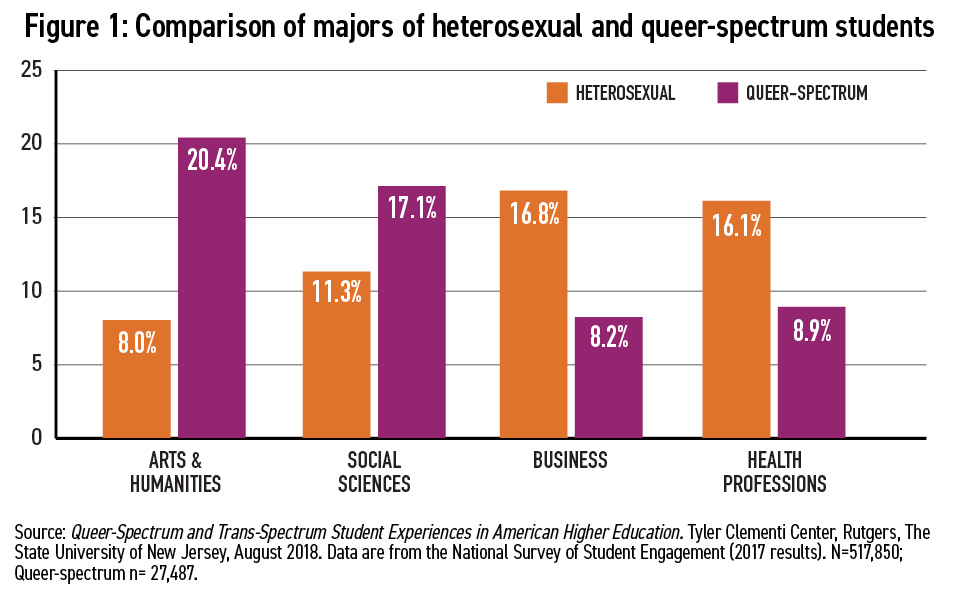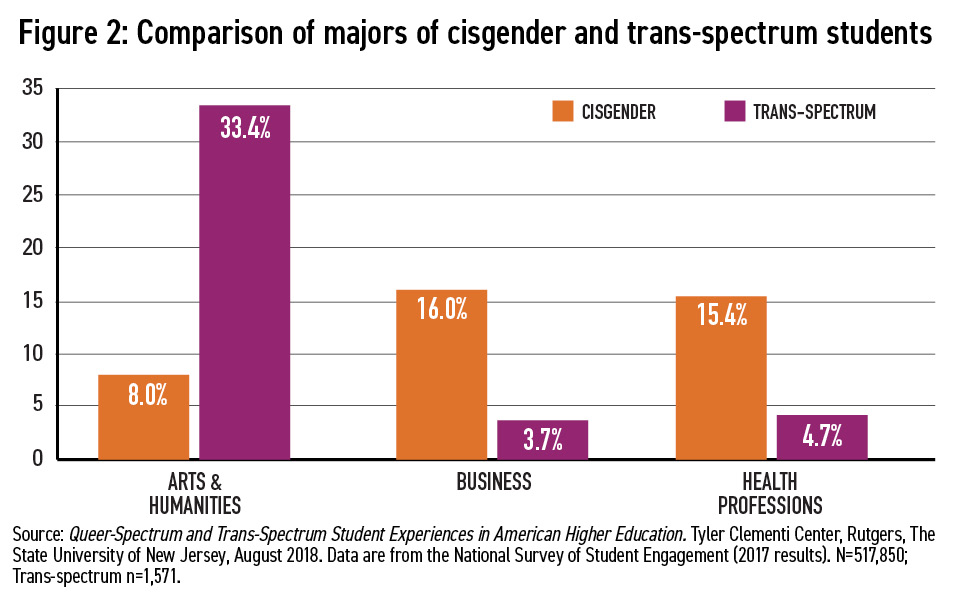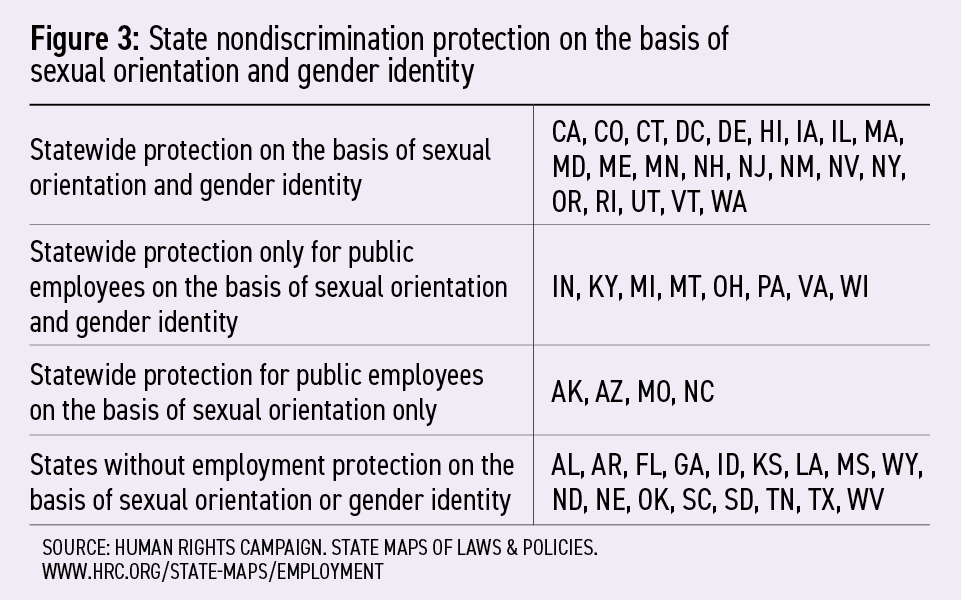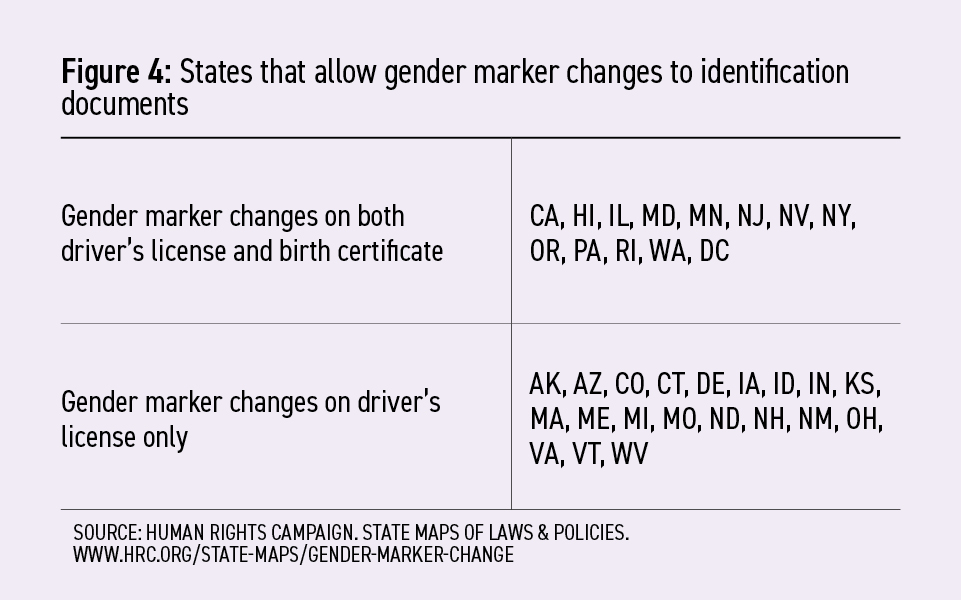NACE Journal, February 2019
College students who identify as lesbian, gay, bisexual, transgender, or queer (LGBTQ) experience unique challenges in the area of career preparation. These students sometimes express caution, concern, and/or apprehension when exploring and selecting a major, pursuing an internship, constructing a resume, stepping into the job market, or all of the above. These concerns may arise due to the historical anti-LGBTQ stigma of a specific profession, indecision regarding whether to disclose their sexual orientation/gender identity to a potential employer, fear of potential bias or harassment in the workplace, and the level of employment nondiscrimination protection provided at the local, state, or federal level.
Career services professionals can offer valuable guidance to LGBTQ students in their career development by understanding the historical and current challenges this population faces, providing culturally responsive resources, and demonstrating LGBTQ-affirming support and encouragement.
Historical Context
Employment discrimination on the basis of sexual orientation and gender identity has a long history in the United States, e.g. lavender scare, moral fitness tests; don’t ask, don’t tell. Unfortunately, the stigma among certain professions persists. Scholars have documented the chilly climate for LGBTQ employees in many fields, including K-12 education, health professions, STEM fields, and many more.
In 2018, the Tyler Clementi Center at Rutgers University convened a national study of 66,208 queer-spectrum students and 6,607 trans-spectrum students, in partnership with the Center for Postsecondary Education (Indiana University-Bloomington), the Higher Education Research Institute (UCLA), the SERU-AAU Consortium (University of California-Berkeley and University of Minnesota), and the American College Health Association. When compared to their heterosexual and cisgender counterparts, LGBTQ students were found to be significantly underrepresented in certain fields, while overrepresented in others. (See Figures 1 and 2.) Consistent with scholarship on these occupations, greater attention must be dedicated to diversifying enrollment, particularly among the fields of business and the health professions.1
Student Experiences and Disclosure
For students who assume leadership roles within LGBTQ-oriented student organizations and projects, as well as students pursuing LGBTQ research or academic coursework, the creation of a resume that reflects these experiences highlights their interpersonal strengths, capacity for leadership, critical thinking skills, and intercultural fluency. However, disclosing those roles comes with risk if the employer has a bias against LGBTQ people. Conversely, omitting these experiences from a professional resume is detrimental to both the candidate and the employer that might weigh these positively in the hiring process.
Students seeking to mitigate possible discrimination will sometimes choose to omit these experiences from their resume entirely, while others will modify the language to describe their experience in the interest of privacy. For example, rather than listing “LGBTQ Student Organization President” on the resume, the student may list “Cultural Student Organization President.”
In the workplace itself, disclosure of one’s sexual orientation or gender identity also comes with risk. Indeed, one in four LGBTQ employees have experienced harassment and discrimination within the last five years.2 However, concealment of these aspects of their identity may be difficult when chatting around the water cooler about upcoming vacations, social events, holiday plans, and so forth. Over time, concealing sexual orientation or gender identity in the workplace can impact physical and mental health, productivity, job satisfaction, and/or relationships with colleagues.3 It is important to talk with students about these concerns, to weigh the cost-benefit of disclosure versus concealment, to review state and local laws governing non-discrimination, to identify employers with LGBTQ-affirming policies and practices, and to develop strategies that assist the student in navigating this aspect of their employment.


Challenges and the Legal Landscape
While it is impossible to predict the potential threat of anti-LGBTQ bias in the hiring process, federal and state legal protections have been established to ensure legal recourse for victims of employment discrimination.
The U.S. Equal Employment Opportunity Commission (EEOC) is the federal agency tasked with enforcing federal nondiscrimination laws that protect employees on the basis of race, color, religion, sex, national origin, age, disability, or genetic information. While this policy provides critical protection for many employed populations, it does not prohibit discrimination on the basis of sexual orientation or gender identity. Employers that adopt the EEOC’s policy language, in lieu of creating a tailored policy that includes additional enumerated categories, unintentionally exclude nondiscrimination protection for LGBTQ employees.
While discrimination on the basis of sexual orientation or gender identity are not protected on the federal level, 33 states and the District of Columbia do offer these protections. (See Figure 3.) For the students residing in the remaining 17 states, the decision to disclose one’s sexual orientation and/or gender identity during the interview or onboarding process is legitimate cause for concern.
During the onboarding process, new employees typically must provide proof of identity for tax forms and complete benefit paperwork for enrollment in health insurance coverage, retirement accounts, and so forth. These onboarding practices have unique implications, particularly for transgender employees. Currently, only 12 states and the District of Columbia afford their residents the option to change the gender marker on their driver’s license and birth certificates, and just 20 states on driver’s license alone. (See Figure 4.) Furthermore, many states require complicated, expensive, and lengthy processing times to change a legal name. This requires many employees on the trans-spectrum to produce identification inconsistent with their gender presentation, necessitating the disclosure of sensitive information to human resources professionals. Among individuals who have not (or cannot) modify identification documents, these requirements sometimes lead to an uncomfortable conversation about personal pronouns, e.g., she/her, he/him, ze/hir, and preferred name, as opposed to legal name. It is crucial that transgender students be afforded opportunities to discuss these challenges and develop a plan for navigating this disclosure to an employer.


Career Services and LGBTQ Students
How can career services professionals create a more equitable and affirming environment for LGBTQ students seeking their services?
- Train staff. All career center staff should have training and professional development that ensures that all members of the team are prepared to create an equitable and affirming environment for LGBTQ students.
- Stay current on state and federal laws governing employment nondiscrimination, workplace access and harassment, and identity documentation.
- Provide students with the chance to identify themselves. Ensure that students are provided opportunities to designate their preferred name and gender pronouns, in writing and verbally. On forms, include optional fields that give students the opportunity to share their sexual orientation, preferred name, and/or personal pronouns. Similarly, provide space on name tags, such as those used at career fairs, for personal pronouns. Ask students how they would liked to be addressed when beginning a one-on-one session. For example, you could share your name and pronouns and then ask the student to do so. Or, you could simply ask, With regard to your name and gender pronouns, how would you like to be addressed?
- Respect and support the student’s autonomy. It is up to the student to decide what to include on the resume, disclose in an interview, or share during the onboarding process. If disclosure is unavoidable, e.g. having to show a driver’s license for federal tax paperwork, encourage the student to share concerns; walk the student through various scenarios and possible outcomes, along with the benefits and risks associated with each choice; and offer words of support and encouragement as the student navigates a difficult decision.
- Offer targeted programming. Host programs that encourage students to navigate these issues, such as a panel discussion with “out” alumni employed in a variety of fields, and provide resources that will assist them in their career preparation. Apprise students of special opportunities: For example, the Human Rights Campaign runs job fairs and conferences targeted to the LGBTQ community.
- Show your support (literally). Be sure LGBTQ students are aware of your support by prominently displaying and marketing resources and programming tailored to this student population.
- Provide students with opportunities to share concerns as they arise.
- Ensure your events respect the LGBTQ population. If there is a dress code for a career fair, for example, it should affirm all genders and avoid reinforcing gender stereotypes. In addition, all students should be provided access to gender-neutral restrooms; remind students to be respectful of anyone who uses these facilities.
- Provide guidance to employers. Encourage those with a solid record with LGBTG employees’ rights to provide that information to students. For example, they could share their organization’s score on the corporate equality index offered by the Human Rights Campaign; those with LGBTQ employee resource groups or similar offerings could share this information by disseminating brochures at a career fair.
By being intentional in their efforts, career services professionals can provide LGBTQ students with support and guidance to help them achieve their career goals.
Endnotes
1 For a more thorough breakdown of all areas of study, see “Queer-Spectrum and Trans-Spectrum Student Experiences in American Higher Education: The Analyses of National Survey Findings” at https://tcc-j2made.s3.amazonaws.com/uploads/2018/09/White-Paper-Final.pdf
2 The 2017 Workplace Equality Fact Sheet, developed by Out & Equal Workplace Advocates, cites relevant statistics. See http://outandequal.org/2017-workplace-equality-fact-sheet/
3 The Cost of the Closet and the Rewards of Inclusion, a report by the Human Rights Campaign, details relevant statistics. See https://assets2.hrc.org/files/assets/resources/Cost_of_the_Closet_May2014.pdf?_ga=2.83119894.1006566474.1547741019-1359859106.1547058780
References
Fast Company (2018, June 11). “A brief (and depressing) history of LGBT workers’ rights.” www.fastcompany.com/40582182/a-brief-and-depressing-history-of-lgbt-workers-rights
Huffington Post (2017, January 25). “How Medical Schools Are Failing the LGBTQ Community.” https://www.huffingtonpost.com/the-establishment/how-medical-schools-are-f_b_9053496.html
Human Rights Campaign. Corporate Equality Index. https://www.hrc.org/campaigns/corporate-equality-index
Ikem, Chinelo. “For LGBT Students, a STEM Career Is a Less Likely Option,” Pacific Standard, April 10, 2018. https://psmag.com/education/lgbt-students-stem-fields
Machado, Amanda. “The Plight of Being a Gay Teacher,” The Atlantic, December 16, 2014, www.theatlantic.com/education/archive/2014/12/the-plight-of-being-a-lgbt-teacher/383619/
National Survey on Student Engagement. Center for Postsecondary Research, Indiana University Bloomington. nsse.indiana.edu.







